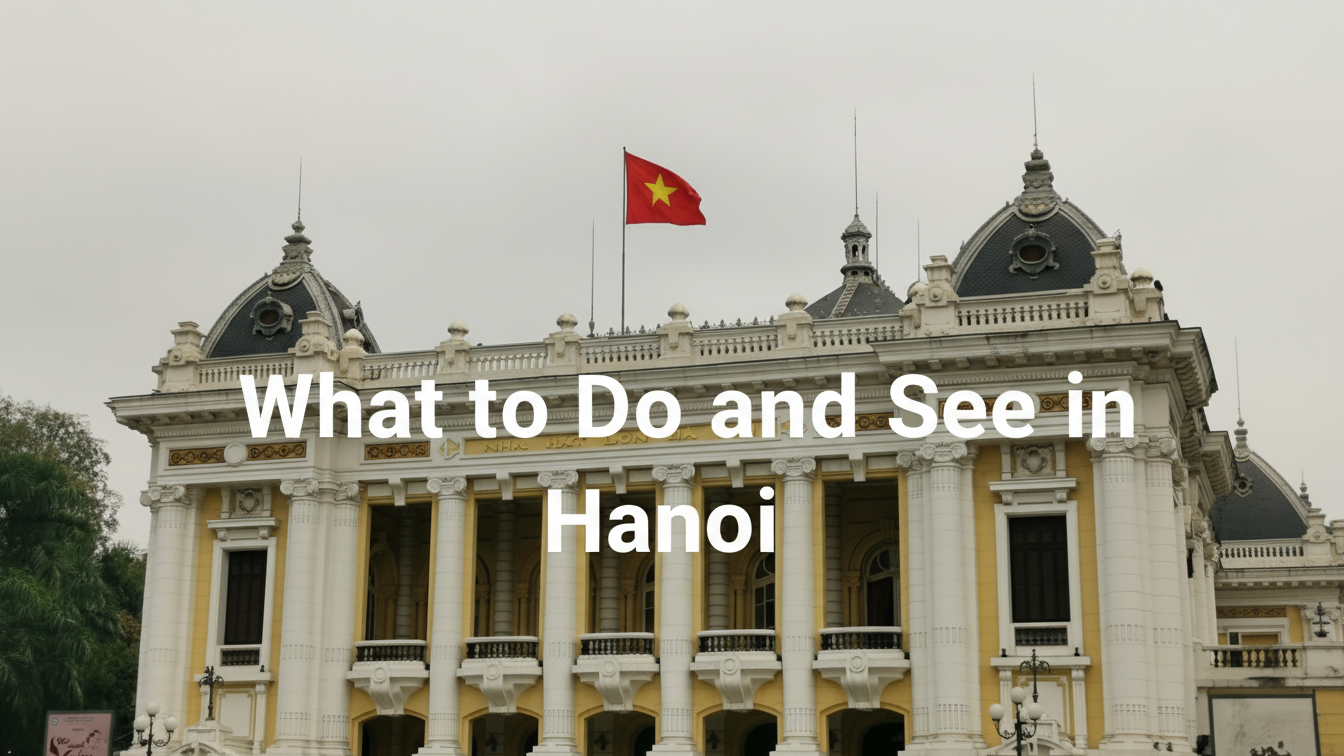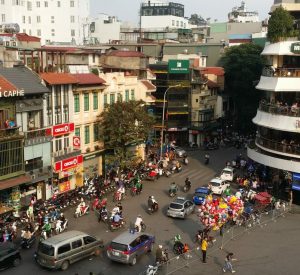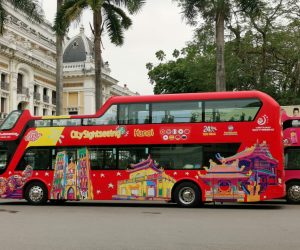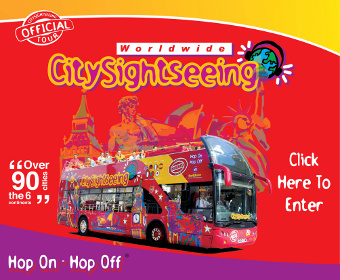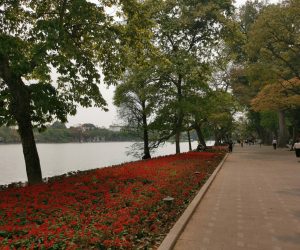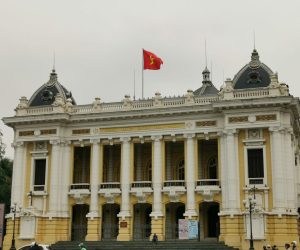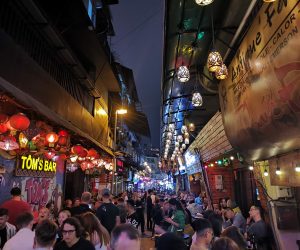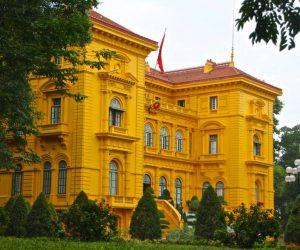A trip to Hanoi is a magical excursion into the heart of Vietnam’s illustrious past, lively present, and alluring charm. Hanoi, the country’s capital, has a special fusion of traditional and modern elements that contribute to its hypnotic ambiance.
With its congested marketplaces, historic buildings, and winding lanes, exploring the Old Quarter is a must. Immerse yourself in the sensory stimulation of the colorful stores, frenetic atmosphere, and street food stalls.
Historical sites in the city, like the Ho Chi Minh Mausoleum and the Temple of Literature, provide a window into Vietnam’s past and its illustrious leaders. Enjoy the tranquil sanctuary of Hoan Kiem Lake while taking a stroll around the city, or visit the busy Dong Xuan Market to observe the frenetic traffic flow.
Foodies will revel in Hanoi’s culinary scene, which offers a wide variety of tastes and cuisines to try. The city offers a culinary excursion that entices the palate, from the famed pho and banh mi to delectable street delicacies.
Additionally, Hanoi is a starting point for day journeys to beautiful natural attractions including Ninh Binh province’s stunning scenery and Halong Bay, both of which are world-renowned.
Hanoi provides a unique and immersive experience that captures the spirit of Vietnam’s capital city with its rich past, lively streets, and wonderful cuisine.
This article, will discuss what you should do and see when visiting Hanoi and the wider region.
Take a Day Trip to Halong Bay
One of the best ways to appreciate the splendor and majesty of one of Vietnam’s most famous locations is to take a day trip to Halong Bay from Hanoi. Towering limestone cliffs, pristine waters, and breath-taking natural landscapes are what make Halong Bay a UNESCO World Heritage Site.
The journey usually begins with a relaxing bus excursion from Hanoi to the coast, which passes through a beautiful rural area. When you arrive, you will join a typical Vietnamese junk boat and set sail on the bay’s emerald waters.
Stunning limestone cliffs that dramatically rise from the water as you navigate the harbour will astound you. They are dotted with lush vegetation and undiscovered caves. In addition to swimming in the clear waters, you can kayak or use a bamboo boat to investigate the caverns and grottos.
Along with the tour, a delectable seafood lunch with fresh regional products and classic Vietnamese flavors is served on the boat. Other options for entertainment include fishing, squid hunting, and even Tai Chi movements on the deck of the boat as the sunsets over the harbor.
In general, a day trip to Halong Bay from Hanoi is a unique experience that provides a fresh viewpoint on one of Vietnam’s most breath-taking natural marvels. It is a trip you should not pass up, whether you’re travelling alone or with family and friends.
If you would like to book a tour to see Halong Bay, click here or on the Viator image below to select from one of our preferred suppliers.
Visit Ho Chi Minh Mausoleum
In Hanoi, Vietnam, there is an important historical and cultural landmark called the Ho Chi Minh Mausoleum. The preserved corpse of Ho Chi Minh, the revolutionary leader who was instrumental in the Vietnamese people’s fight for independence and unity, rests in the mausoleum.
The structure of the building itself is impressive, with a straightforward yet imposing design that reflects Ho Chi Minh’s humility and commitment to serving the Vietnamese people. When viewing the mausoleum, visitors must adhere to a strict dress code and behave respectfully.
Inside, the embalmed corpse of Ho Chi Minh is on display, lying in state and encircled by flowers and the Vietnamese flag. Visitors are prohibited from taking pictures or making sounds, and the ambiance is solemn.
The Ho Chi Minh Mausoleum serves as a visual representation of the Vietnamese people’s enduring respect and admiration for Ho Chi Minh and the historical accomplishments he made to their nation. Anyone interested in Vietnamese culture and history should go there because it offers a distinct perspective on the country’s past and present.
3. Explore the Old Quarter
In the centre of the city of Hanoi, there is an ancient area known as the Old Quarter. It is a thriving and busy neighborhood recognized for its small-town charm, classic style, and lively culture.
The region has a long past that dates back more than a thousand years, and it is home to a large number of temples, pagodas, and other landmarks that showcase the varied cultural influences that have influenced Vietnam. The Dong Xuan Market, one of the highlights of the Old Quarter, offers tourists a wide selection of regional products, including clothing, handicrafts, and street food.
Authentic Vietnamese dishes like pho, banh mi, and bun cha are available for visitors to taste at the Old Quarter’s famed street food vendors. A favorite destination for both locals and visitors, the area is also home to a large number of cafes, bars, and restaurants.
Experiencing the city’s rich history and culture first-hand while strolling through the Old Quarter is a distinct experience. For anyone interested in Vietnamese history and culture, it is a must-go location. It also offers a fantastic chance to discover the city’s varied and vibrant neighborhoods.
If you would like to book a City tour to see some of Hanoi’s highlights, click here and go to Get Your Guide or one of our other preferred suppliers to book a tour.
Hop on Hop Off Bus Tours in Hanoi
Hop on, hop off Bus tours are a well-liked method to see a new city without having to worry about figuring out how to use the public transportation system or where to park. There are numerous businesses in Hanoi that provide hop-on, hop-off bus tours, allowing visitors to see the sights at their own speed.
The tours usually take visitors to Hanoi’s most popular tourist destinations, including the Ho Chi Minh Mausoleum, the Temple of Literature, and the Old Quarter. The buses make stops along the route so that people can disembark, walk around the area, and then board again to continue the tour.
Seeing a lot of the city in a short period of time is one of the benefits of Hop on Hop off Bus Tours. They also provide a convenient and cheap way to do so. They also give visitors an overview of the city’s history, culture, and design. In addition to offering audio commentary in several languages, many of the tours also give tourists the chance to learn about the city’s extensive history.
In general, hop on hop off Visitors who want to experience Hanoi’s top attractions conveniently and affordably have a lot of options, but bus tours are one of the best.
If you would like to book a hop on hop off bus tour in Hanoi, click here or on the CitySightseeing image below to select from one of our preferred suppliers.
Try the Local Cuisine
There are many traditional dishes to tempt your taste buds in Hanoi, which is famous for its delectable and varied cuisine. Pho, a rice noodle soup with meat, veggies, and herbs, and banh mi, a Vietnamese-style sandwich with a variety of meats, vegetables, and sauces, are two of the most well-liked regional meals.
Other well-liked meals include cha ca, a grilled fish dish, and bun cha, a dish of grilled pork and noodles. Another specialty of Hanoi is egg coffee, a creamy, frothy beverage prepared with egg yolks and condensed milk.
The city’s street food stalls and markets offer a variety of delectable and reasonably priced dishes, making them one of the best places to sample the local cuisine. Some of the best locations to sample local cuisine are the Old Quarter, which is home to a large number of street food vendors and cafes, and the Dong Xuan Market, which has a huge selection of regional foods and products.
Overall, experiencing the native cuisine in Hanoi is a must for any foodie and is a great way to learn about the history and traditions of the city.
If you would like to book a cooking class for some looking cuisine or a cooking class, click here or on the Klook image below to select from one of our preferred suppliers.
Visit the Temple of Literature
A well-known historical and cultural site from the 11th century, the Temple of Literature is situated in Hanoi. It was initially constructed as a Confucian temple, but in 1076, it was transformed into Vietnam’s first national university, where people could come to learn literature, philosophy, and other subjects.
The Gate of Great Success, the Hall of Great Achievements, and the Imperial Academy are just a few of the shrine complex’s magnificent buildings and courtyards. Traditional Vietnamese architecture is present in the structures, which includes elaborate sculptures and vibrant tile work.
Explore the serene gardens, tranquil courtyards, and halls filled with displays and artefacts that detail the temple’s lengthy past. The location serves as a centre for cultural and educational action throughout the year by hosting traditional cultural events and festivals.
Anyone interested in Vietnamese history and culture must tour the Temple of Literature, which also provides a rare chance to learn about the Confucian philosophy and the country’s traditional educational system.
Explore Hoan Kiem Lake
The tranquil and scenic Hoan Kiem Lake, which is in the centre of Hanoi, provides a tranquil respite from the busy city streets. Visitors can stroll around the lake’s perimeter on a picturesque path and enjoy the stunning views of the lake and the nearby structures. A lush greenery surrounds the lake.
On an island in the centre of the lake, the Ngoc Son Temple, a historic temple, is one of the lake’s many landmarks. Stunning views of the water can be seen from the red-painted wooden bridge that connects visitors to the sanctuary.
The lake is a favorite early hangout for locals who want to exercise, practice Tai Chi, and take in the fresh air. When the lake is beautifully lit up at night, a magical ambiance is created that is ideal for a romantic walk.
Hoan Kiem Lake offers a tranquil and lovely escape from the city’s hubbub, making it a must-visit location for anyone travelling to Hanoi.
Visit the Hanoi Opera House
In the centre of Hanoi is the breathtaking Hanoi Opera House, a structure designed in the French colonial manner. One of the most well-known landmarks in the city and regarded as one of Southeast Asia’s most exquisite opera halls, it was constructed in 1911.
The structure has an elaborate façade with large columns, arched windows, and a steep roof covered in delicate details. With 600 seats and gorgeous chandeliers and intricate carvings throughout, the auditorium is equally remarkable on the inside.
Numerous cultural events are held at the opera house, such as opera performances, ballets, symphony concerts, and performances of indigenous Vietnamese music. It’s also available to visitors during the day and offers guided tours that reveal information about the structure’s history and design.
For anyone interested in the performing arts or colonial building, the Hanoi Opera House is a must-see location. One of Hanoi’s most famous landmarks and a place of great cultural importance, it offers visitors an unforgettable experience.
Shop at Dong Xuan Market
In the centre of Hanoi’s Old Quarter, there is a thriving interior market called Dong Xuan Market. The market dates back to the late 19th century and is one of the largest and oldest markets in the city.
Fresh fruit, meat, seafood, clothing, handicrafts, and electronics are just a few of the many items that visitors can discover at the market. The market is renowned for its textiles and fabrics, and customers can find a broad selection of premium silk and cotton fabrics at reasonable prices.
The sights, sounds, and smells of the busy market create a lively atmosphere, making exploring it a thrilling and sensory experience. Visitors can practice their negotiating skills to get the best prices. Bargaining is an essential component of the market experience.
For anyone interested in experiencing the genuine sights and noises of Hanoi’s markets, Dong Xuan Market is a must-visit location. It offers a window into the everyday lives of city residents as it is a distinctive and active centre of commerce and culture.
Day trip to Bac Ha Market
In the mountains of Northern Vietnam, there is a bustling and colorful market called Bac Ha Market. Both residents and visitors are drawn to it because it is one of the biggest and most varied markets in the area. The market, which is held every Sunday, provides a special chance to get to know the locals and engage with the Hmong and other ethnic minorities.
The vibrant and intricately crafted traditional Hmong apparel is the market’s most well known textile. Fresh produce, herbs, handicrafts, and livestock are just a few of the numerous additional items that visitors can discover. Visitors can sample a variety of traditional Vietnamese dishes at the market, which is also a famous location for local street food.
Bac Ha Market is more than just a marketplace for buying and selling goods; it serves as the social centre for the neighborhood, where locals congregate to meet up with old friends, make new connections, and take in the lively atmosphere. For those who want to immerse themselves in Northern Vietnam’s rich and varied culture, it is a fantastic place to go.
If you would like to book a tour to do a day trip to Bac Ha Market, click here and book from one of our preferred suppliers.
Drinking Street
Is renowned for its thriving street culture and active entertainment. The Old Quarter’s “drinking street,” also known as “Ta Hien,” is one of the most well-liked tourist and local locations.
Ta Hien Street, which is surrounded by bars, pubs, and street vendors and is only a short stroll from Hoan Kiem Lake, offers a wide selection of regional and foreign alcoholic beverages and foods. In the evenings, a large number of people of all ages congregate on the street to socialize, drink, and talk.
In addition to its drinks and cuisine, the street is renowned for its atmosphere, with its small lanes and vibrant lanterns fostering a warm and cosy ambiance. It is the ideal location for unwinding after a long day of touring Hanoi or catching up with friends over a cold beer.
Overall, the Hanoi drinking street is a must-see location for anyone seeking to experience the dynamic and social culture of the city.
Presidential Palace
In the centre of Hanoi, Vietnam, the Presidential Palace, also referred to as the Presidential Palace of Hanoi, is a famous historical structure. The Governor-General of Indochina lived there when it was constructed in the early 20th century during the French colonial period. The President of Vietnam currently resides there in formal capacity.
Beautiful French and Vietnamese influences can be seen in the design of the Palace. It is surrounded by impressive verdant grounds and has a regal yellow facade with white trim. From the outside, visitors can take in the grandness of the structure, but only formal government events are permitted inside.
Due to its historical importance and stunning architecture, the Presidential Palace continues to be a well-liked tourist destination despite its restricted accessibility. The palace’s façade is breath-taking, and guests are welcome to stroll around it and take pictures. It is an easy stop on any sightseeing trip of Hanoi because of the nearby attractions, the Ho Chi Minh Mausoleum and the One Pillar Pagoda.
In conclusion, Hanoi is a distinct and energetic metropolis that provides a wealth of cultural, historical, and gastronomic experiences. There are many things to do in Hanoi, including exploring the city’s historic buildings, sampling the food, and visiting its thriving street markets.
Day Trip to Sapa
An excellent way to enjoy the splendor of the Northern Vietnam mountains and countryside without committing to a longer stay is to take a day excursion to Sapa from Hanoi. The charming town of Sapa, which is situated in the Hoang Lien Son Mountains, is well-known for its breath-taking landscape, dynamic culture, and energetic markets.
The journey typically begins in Hanoi with a beautiful drive through the country’s lovely scenery. Once you get to Sapa, you can go exploring. You can enjoy the breath-taking views of the rice terraces, go to nearby communities, and get to know the local ethnic minority groups.
Trekking or hiking through Sapa’s forested mountains, where you can take in the fresh air and breath-taking scenery is a well-liked exercise. Additionally, there are numerous handicrafts, clothing items, and fresh food items available at the neighborhood marketplaces.
The beauty and culture of Northern Vietnam can be experienced in a day trip from Hanoi to Sapa, which is why it is a well-liked location for both tourists and locals.
If you would like to book a tour to Sapa to do a day trip to Sapa, click here and click on the Get Your Guide banner below and book from one of our preferred suppliers.




